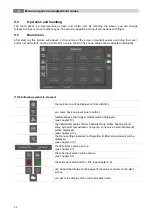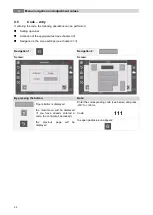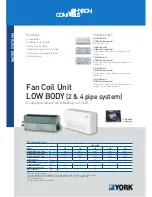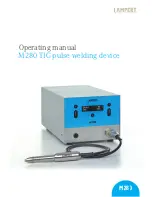
Fuels
3
7
3
FUELS
3.1
Wood chips
Wood chips for non-industrial use with low fines
content according to EN 17225-1/4 with following
specification:
◼
Property class A1, A2, B1
◼
Particle size P16S, P31S and P45S
•
G30 resp. G50
4
◼
Water content min. 15 % to max. 40 % *
◼
Ash content in m-%: <1.0 (A1), <1.5 (A2), <3.0
(B1) m-%
◼
Calorific value at as-delivered condition >
3,1 kWh/kg
◼
Bulk density (BD) at as-delivered condition >
150 kg/m³
The property classes A1 and A2 represent fresh
wood and chemically untreated wood residues. A1
contains fuels with low ash content, which
indicates little or no bark and fuels with lower
water content, while class A2 has a slightly higher
ash content and/or water content. B1 extends
origin and source of class A and includes
additional materials, such as short rotation
plantation wood, wood from gardens and
plantations etc., as well as chemically untreated
industrial wood waste. Class B2 also includes
chemically treated industrial wood waste and used
wood.
3.2
Wood pellets
Wood pellets for non-industrial use according to
ENplus,
Swisspellet,
DINplus
resp.
pellets
according
to
EN
17225-2
with
following
specifications:
◼
Property class A1, A2
◼
The maximum permissible fines content in the
fuel storage room must not exceed 8 % of the
fuel volume (determined using a perforated
screen with holes 5 mm in diameter)!
◼
Fines content at loading: < 1.0 m-%
◼
Calorific value at as-delivered condition >
4,6 kWh/kg
◼
Bulk density (BD) at as-delivered condition >
600 kg/m³
◼
Mechanical Strength (DU), EN 17831-1 at as-
delivered condition in m-
%: DU 97,5 ≥ 97,5
◼
Diameter 6 mm
The nominal power and the emission values can
be guaranteed up to a maximum water content of
4
Only
if
using
an
agitator
with
3x400
Volts
* at execution @M50 to water content 50%
25 % and a minimum calorific value of 3.5 kWh/kg
of the permissible fuel.
From a water content of about 25 % and a
calorific value < 3,5 kWh/kg a reduced output is
expected.
Prevent the entering of debris such as stones
or metal particles into the system! Sand and
soil lead to higher level of ash and slagging
precipitation.
There may be a formation of slag according to the
fuel quality, which has to be removed by hand.
In the case of non-compliance, any warranty
or guarantee will be rendered null and void.
The burning of unsuitable fuels could lead to
uncontrolled combustion. Operational faults
and consequential damage are likely to occur.
If a different fuel is named explicitly on the order
respectively the order confirmation, the system
can be operated with the mentioned fuel.
Note: The system is set to the agreed fuel at the
commissioning. This setting (ID-fan speed, fuel,
flow and backflow, cycle times, etc.) should not be
changed when using constant fuel quality.
3.3
General fuel properties
Calorific value
(
Minimum calorific value (Hu) of the
fuels to be used)
:
•
6-20% wt
M20 water content „W20“: 4,0kWh/kg
•
21-
30% water content M30 or „W30“: 3,0kWh/kg
•
31-
40% water content M40 or „W40“: 2,5kWh/kg
•
41-
50% water content M50 or „W50“: 2,5kWh/kg *
Calorific value (Minimum calorific value
(of the
fuels to be used))
E = 800kWh/m³
Minimum heat consumption
(Permanent minimum
heat consumption (24 hours) to maintain the
combustion):
•
20% the nominal output for dry fuelM20 or „W20“
•
40% the nominal output for wet fuel M40 or „W40“
•
40% the nominal output for wet fuel M50 or „W50"
Summary of Contents for BioFire 1000
Page 1: ...OPERATING INSTRUCTIONS Wood chips pellets heating system BioFire 500 600 800 1000 1250 1500 ...
Page 89: ...Annex 14 89 14 ANNEX 14 1 Additional boiler module Hydraulic recommendation 1 ...
Page 90: ...14 Annex 90 Hydraulic recommendation 2 ...
Page 91: ...Annex 14 91 14 2 Solar module Program 1 ...
Page 92: ...14 Annex 92 Program 2 ...
Page 93: ...Annex 14 93 Program 3 ...
Page 94: ...14 Annex 94 Program 4 ...
Page 95: ...Annex 14 95 Program 5 ...
Page 96: ...14 Annex 96 Program 6 ...
Page 97: ...Notes 15 97 15 NOTES ...








































